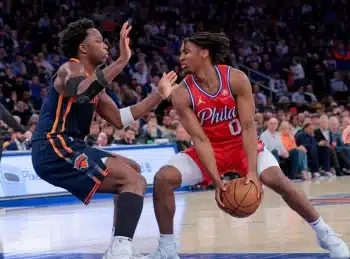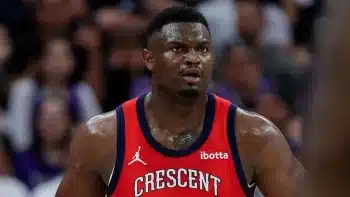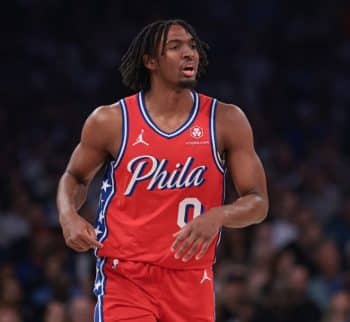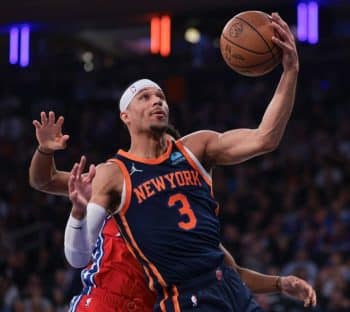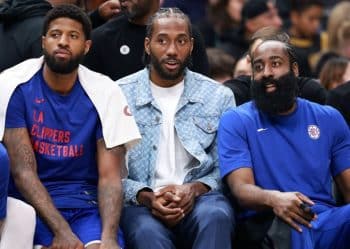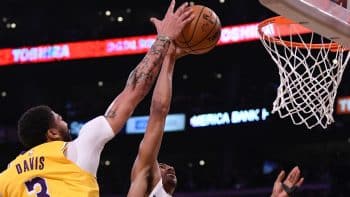NBA
NBA Rookie Extensions: Utah Jazz

The 2014 rookie-extension class is one of the most interesting in several years due to the high number of quality players entering their fourth seasons. As most readers likely know by now, teams have until October 31 to reach extensions with first-rounders entering their fourth season or the players become restricted free agents next summer. This year, many of these players fall into the fascinating middle ground between total busts and obvious max outs, and their negotiations are further complicated by the unknown effect of the league’s recently-announced new TV deal.*
Due to the rising cap, it is useful to think of new deals in percentage terms. For example, a $10 million contract under the $58.044 million cap in 2012-13 was 17.2 percent of the cap. For the 2016-17 season, assuming the cap is $80 million for that year, an equivalent contract would be $13.8 million.
Alec Burks
Age: 23 (July 20, 1991)
Draft Position: 12
2013-14 PER: 15.82
2013-14 ORPM: 1.43
2013-14 DRPM:-1.74
2015 Cap Hold: $7,585,890
2015 Qualifying Offer: $4,175,274
At 6’6 with a 6’10 wingspan, Burks has prototypical shooting guard size and quickness. His greatest asset is his ability to get to the basket off the dribble. Burks took over 50 percent of his shots inside of 10 feet a year ago, and shot an outstanding-for-a-guard .644 within three feet. The Colorado product got to the foul line like crazy, boosting his True Shooting Percentage to .547, well above the league average for shooting guards. He also showed improvement on threes, although he needs to replace more of his long twos with those considering he shot about 35 percent on both types of shots.
Burks has a lot to work on, like most 23-year-olds. He suffers from a bit too much freelancing on both ends, but the hope is that Quin Snyder can reign him in while still allowing him the improvisation that makes him a tough guard offensively. Burks needs more concentration applying his tools defensively, but at least he has them. And he needs to improve his shot from downtown and get better at creating for others. But unlike a lot of extension candidates, Burks has already shown proficiency (or at least improvement) in the areas that will make him worth the money he is seeking. A fully-formed Burks will have the same core skills as the present version, only better.
Burks’ skills are also a solid fit with the existing roster, since Trey Burke, Gordon Hayward and (eventually) Dante Exum should be able to provide shooting around his drives while Derrick Favors and Rudy Gobert make solid pick and roll partners. Burks also helps reduce the need for a backup point guard, allowing the Jazz to utilize smaller shooters with less playmaking ability should they so choose. With the dearth of wings around the league, Burks’ value over replacement offensively is higher than at, say, point guard.
So what is Burks worth?
Burks is by nearly all measures the superior player to DeRozan when he was extension eligible at the same age. The Toronto Raptor received a then-panned but now-steal four-year, $38 million deal.* DeRozan is the superior athlete and perhaps could be seen as higher ceiling, and now at age 25 he has morphed into one of the league’s better shooting guards. Nevertheless, it is very conceivable Burks could reach that level, especially considering the upgrade in coaching from Tyrone Corbin to Snyder.
When DeRozan signed his deal for a flat $9.5 million per season, it represented 16 percent of the cap, which will fall to 12 percent over the life of the deal. That amount of the projected $67 million cap would be $10.7 million when Burks’ extension kicks in for 2015-16.
It seems pretty clear that there is a deal to be made here that provides Burks life-changing financial security while giving the Jazz some upside if he blows up, which is a reasonable proposition. Burks’ agent Andy Miller has enough clients that he does not need to rely exclusively on Burks’ deal to impress. The sides should be able to play with the particulars to make a deal with a starting salary in the $8 to $11 million range. A few options:
- Provide Burks more money up front with a declining salary, since the Jazz are more likely to be at the point of adding free agents near the end of his deal as the cap rises.
- Give the maximum annual raises to start Burks lower and allow more room to add a piece in 2015 (more on that below).
- A player option for Burks’ fourth year to mitigate the risk on his end in case he reaches All-Star level as the cap rises.
Burks has enough upside to make such an extension worthwhile for the Jazz, while it is hard to imagine he is not at least a starting quality two (or top-sixth man type) even on the downside. It is highly possible that Burks was really held back by Tyrone Corbin and Utah could be buying low right now. This is a deal that can and should get done, and at these numbers it should not hamstring the Jazz’s future flexibility. (More on that below.)
Enes Kanter
Age: 22 (May 20, 1992)
Draft Position: 3rd
2013-14 PER: 15.70
2013-14 ORPM: -2.88
2013-14 DRPM: -1.75
2015 Cap Hold: $11,389,348
2015 Qualifying Offer: $7,471,412
The Jazz may have less information on Kanter than any team has on an extension candidate. Kanter was famously ineligible at Kentucky in the 2010-11 season. He was the fourth big his first two years behind Al Jefferson, Paul Millsap and Derrick Favors, although he posted impressive per minute numbers.* When the first two departed prior to last year, the Jazz hoped to get a look at their theoretical frontcourt of the future. But that pairing proved disastrous on both ends in a 1-14 start, necessitating a return to the bench for Kanter behind Marvin Williams.
The strengths that made Kanter the number three pick in the draft are still evident. He has an excellent touch around the rim, hits the offensive glass hard, possesses great strength and can score in the post. But his limitations, especially at center, have really prevented him from playing winning basketball to this point. He does not protect the rim, is not quite quick enough to defend the pick and roll and has struggled on the defensive glass at times. Those limitations have been exacerbated by his lack of experience, as he has struggled to execute the system defensively and has not flashed much passing ability as yet. As a result, Kanter was among the worst regular players in the league last year by plus/minus metrics. The Jazz were outscored by 10.8 points per 100 possessions with Kanter on the floor, but only 2.8 points/100 when he sat. ESPN’s Real Plus-Minus rated him 409th in the league. That’s bad–far beyond salvaging with a free frogurt.
While big men who could score inside were once coveted, the league has turned away from traditional pivotmen, as detailed by Grantland’s Zach Lowe. As he explained, the league has had progressively less use for big men who do not shoot threes or protect the basket. While Kanter was not mentioned in the piece, he very well could have been.
A related issue is how well Kanter fits with Utah’s other long-term bigs, Favors and Gobert. At one time, Kanter was considered the center in the pairing with Favors. But by last season it became apparent that Kanter does not protect the rim well enough, and Favors does not shoot well enough, to support that role for Kanter on either end. Gobert, of course, is a center all the way. With Favors a year ahead of Kanter while possessing a higher upside (especially on defense), it has fallen on Kanter to change his game.
Those efforts have been somewhat hamstrung by health problems, as he missed much of the past two summer due to shoulder and knee injuries. Nevertheless, Kanter has made some solid strides in this area that should not be ignored. He has transformed his body, lowering his body fat significantly and getting much quicker. Becoming fleet of foot is too much to expect, but Kanter has at least evolved beyond traffic cone status, even for a four.
More important though is his potential evolution to a more outside-oriented game under new head coach Quin Snyder. Kanter has been encouraged to take three-pointers after taking only one last year. While he managed only 3-15 in the preseason, even taking those shots has its own value. The Turk also increased his assist percentage this preseason in Snyder’s system, which demands more ballhandling and passing out on the floor from big men. The hope is that Kanter can complete the evolution to a stretch big who can also take advantage of smaller fours on the block.
The problem for the Jazz is that Kanter’s ultimate evolution remains a mere hope at this point, as ESPN’s Kevin Pelton’s projections for this year indicate. While he could ultimately evolve into an offensive force at the four who can drain threes, post up, pass and adequately defend his position, he has only come close to showing one of those skills in his career. Moreover, he is never going to be one of the more athletic big man in the league. His defensive ceiling is probably league-average at power forward, and even worse at center. That is not the end of the world next to quality defensive bigs like Favors and Gobert project to be, and the superstarless Jazz may need his offense going forward even if he has defensive shortcomings. But it also limits the Jazz’s upside defensively, especially without any other players who project as true perimeter stoppers among their young talent.
Despite these limitations, Kanter is worth an extension if he can become an efficient 20 points per game scorer. He certainly has that potential, but the chances of fulfilling it are quite uncertain. Given this risk, it really only makes sense for the Jazz to extend him at a price that would make him underpaid if their bet on him pays off. Even if he reaches his absolute full potential, Kanter is not a maximum type player due to his defensive limitations as a frontcourt player. And if he does not manage the transformation the Jazz envision, he may not even be a starting-quality big man. Value-wise, he will likely range between a $12 million a year player on the high end and a $7 million a year player on the low end over the life of the contract, at least based on the $67 million projected cap in 2015. A four-year extension around $9 million a year would probably be fair. A player option for the fourth year might mitigate the risk for Kanter if he blows up, allowing him to hit the market again at 26 after the 2018 season when the cap will be much higher. Orlando’s Nikola Vucevic, a true center who is probably better (though older), got a four-year, $48 million extension.*
Would Kanter take such a deal? Probably not. Because he was the number three pick, his salary is much higher than later-drafted players like Burks, Klay Thompson and Jimmy Butler with qualifying offers below $5 million. Kanter makes $5.7 million this year, and even if he doesn’t get any bites in restricted free agency next summer, the qualifying offer will still pay him $7.4 million. That is a real game-changer from other potential restricted free agencies. Unless Utah offers a starting salary significantly above that on a long-term deal, Kanter would have little reason to accept because the opportunity cost isn’t nearly as high as for lower-drafted players.* And due to anchoring, a raise of a couple million a year probably will not entice Kanter the way it would for a lower-paid player. Then consider that Kanter is the only big-name client for his agent Max Ergul, and there is even more reason to believe they will hold out for a big deal.
On the other hand, the risk for the Jazz in offering into eight figures a year is significant. They are not even sure that Kanter is part of their future, and he has already suffered a fair amount of injuries. Unlike players like Butler, Thompson and Kawhi Leonard, the threat of a Parsons-style offer sheet may not scare the Jazz, as they likely are not sure that they want to commit to him for big dollars over four years anyway. And while lots of teams will have cap room in restricted free agency, no teams jump out as wanting to break the bank for a scoring big like Kanter who needs to be paired with an elite rim-protector. That is especially so because such teams will have to really overpay to make accepting an offer in restricted free agency more palatable to Kanter than just taking the high qualifying offer.
Although he has a high offensive ceiling, Kanter is so far from reaching it and has played so little until now that the downside of potential overpayment likely overshadows the risk that he blows up this year and gets a huge offer in restricted free agency. Maybe, one could argue, Corbin really held the Jazz back and they would be wise to lock up these players before Snyder boosts their value. But on the other hand, one could argue that Gobert could well eclipse Kanter as a prospect this year, and if he and Favors can find a way to make it work offensively they could form a monster defensive frontcourt. In that case, there really is not room for Kanter to make eight figures on this team long-term.
Depending on what happens with the team and Gobert this year, there is a possible (though not likely) scenario in which it behooves the Jazz to move on from Kanter in the next two years. If the Jazz surprise and get into the 30s in wins, they may want to add a three and D wing in free agency this summer as they try to ascend to the playoffs. Someone like Wesley Matthews, Danny Green, Luol Deng or Arron Afflalo would provide veteran defense and shooting on the wing as a better fit than Kanter. Such a signing would also allow the Jazz to play small with Gordon Hayward at the four.
But to have enough space for such a player, Kanter’s Bird Rights would have to be renounced and his qualifying offer revoked (which can be done through July 23 without his consent). His cap hold is $11 million, and he likely would not sign the qualifying offer to reduce his cap number to the $7.4 million until late in the summer. With a cap hold for Kanter and an extension starting around $9 million a year for Burks, the Jazz probably would not have enough room to overpay (likely a necessary evil) for a meaningful wing, especially after accounting for a 2015 first-round pick.

However, the Jazz would not have to renounce Kanter until they knew if a free agent were coming. If they extend Kanter and Burks now though, it would likely foreclose any major free agent addition in 2015, and even leave them without a ton of cap space (relative to the rest of the league) in the crazy summer of 2016 when the cap goes up.
Thus, there is the very real possibility that the Jazz may want to part with Kanter during one of the next two summers. Meanwhile, any extension they’d be willing to give would not be enough of a raise for Kanter to make it worthwhile. With such misaligned incentives, an extension makes little sense for either side.


